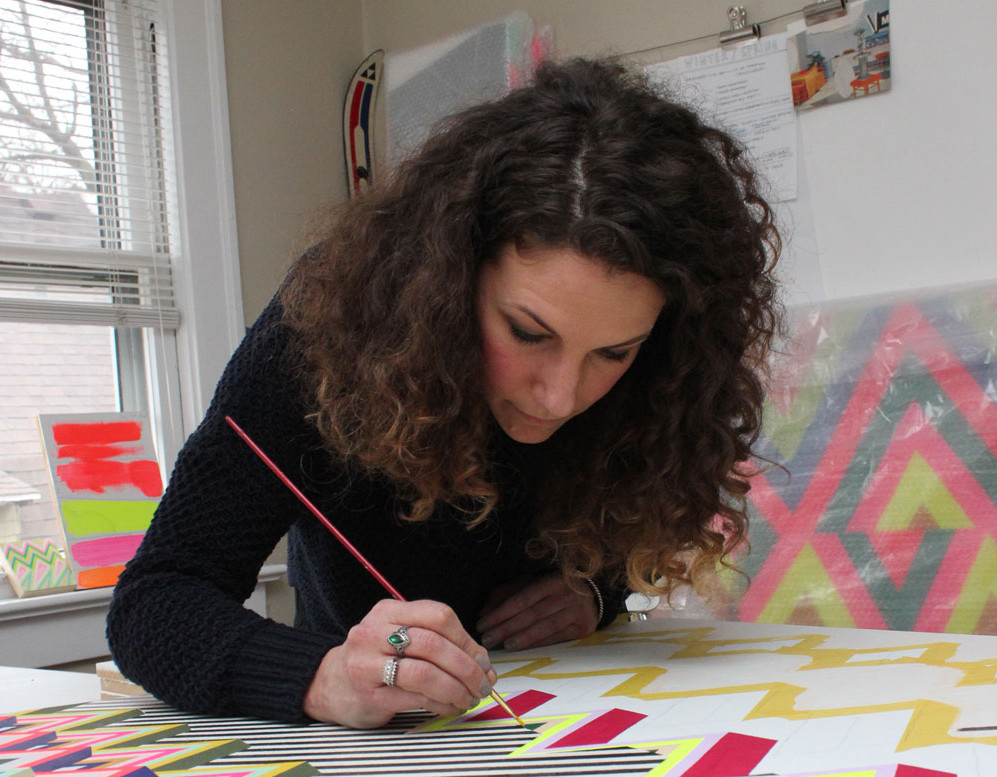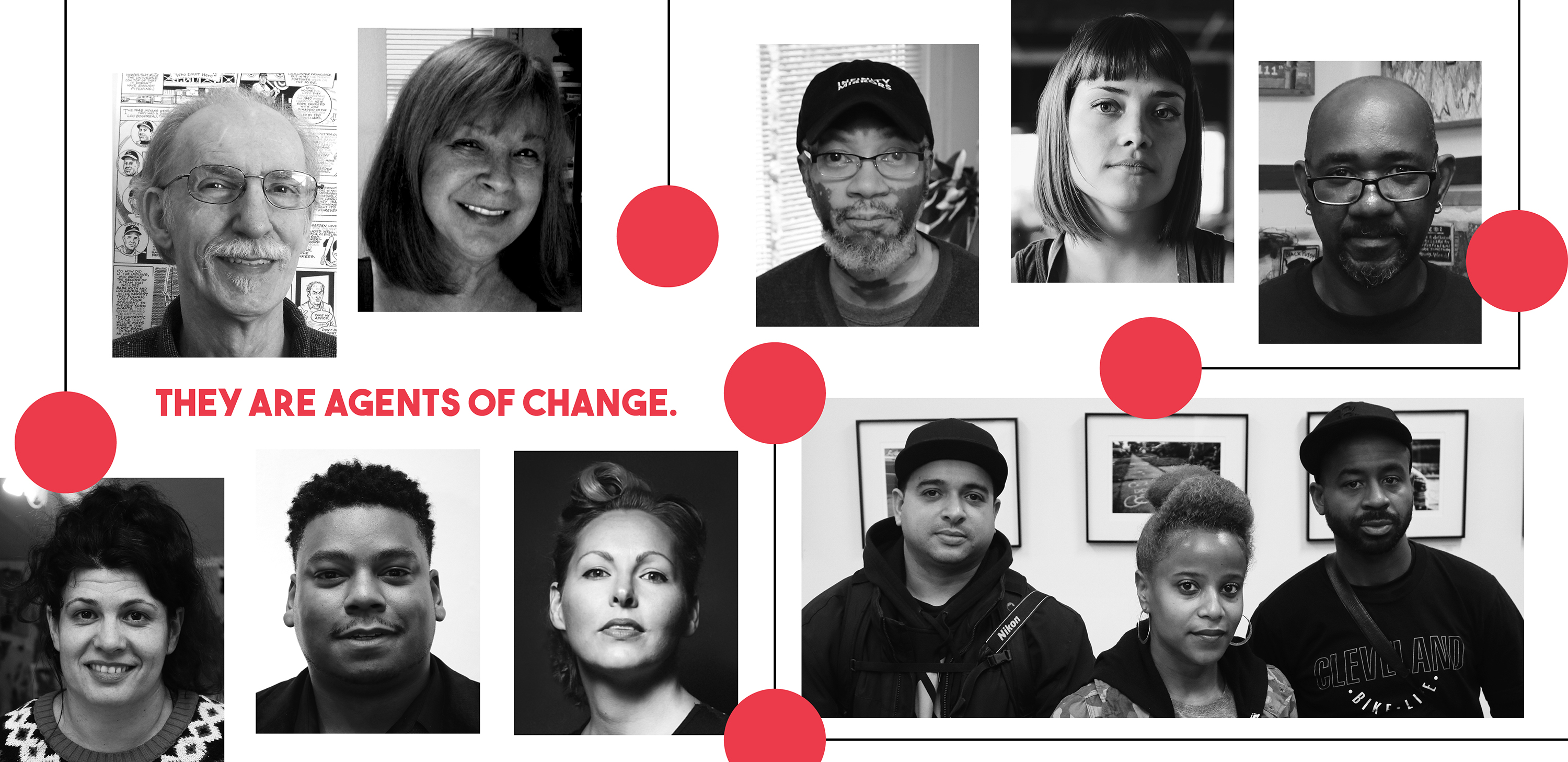Scott Pickering’s art lights up Slavic Village, Cleveland
Story by Carlo Wolff
Photography by Michael C. Butz

Hundreds of works of art line the walls and fill the empty spaces of Pickering’s home, including many playful pieces that are fun to mimic.
Scott Pickering surveys his backyard and the one next door and rants. His is chock-full of things he’s collected and transmogrified, creating a kind of electric garden. Next door, there’s a stove, tires, an inner spring.
There goes the neighborhood. Pickering would like to goose it back to life.
Pickering is an artist, a funny one. He can also be an angry one. The 54-year-old Mentor native has lived in Slavic Village for decades, his frame house is paid for, and he’s engaged in changing the profile of Slavic Village from poster child for the foreclosure crisis to a safe haven for creatives like himself.
That isn’t easy.
Still, he perseveres, using his own household as a sort of easel, from the painted front porch swing to the two- and three-dimensional artifacts that animate the rear. Not to mention all the stuff inside a house so crammed it’s hard to navigate.
“I’m a big hoarder,” he says. “The garage is full of crap that I plan on ‘transmorphing’ into some sort of entity, some final art piece.”
He’s also into creating art “that lives for a minute, and then it’s crushed,” like the houses in Rooms to Let, a Slavic Village Development project that creates temporary art exhibitions in foreclosed homes about to be demolished.
“That’s very of-the-moment,” says Pickering, who enjoyed working on the 2014 Rooms to Let. “It speaks to me on a very personal level that nothing is forever, which is intense. Getting older, I think about it – issues, life issues. I mean it’s like, you know, life is fleeting, you got to go for it – I mean really, really go for it.
“Doing the art, I really love it,” says Pickering, who also is a drummer, known for powering the legendary Cleveland band, Prisonshake. He also worked with Easter Monkeys, Speaker/Cranker and Spike in Vain and now participates in seven or eight bands, including Das Fin.
His home is awash in compact discs (there’s a wall of vinyl, too) spanning groups as diverse as the Flesh Eaters, Thelonious Monk and Led Zeppelin.
Music and art continue to fuel him.
“Pop” is the word for Pickering World: his art is bright, upbeat, guileless and scrambled. One acrylic, ominous even as it draws a chuckle, shows a Viking helmet floating in space with no head to occupy it. Another is a beige-and-white acrylic called “Lady With the Candle Head.” It shows a woman with candles popping out of her head.
“I’m sure I’ve seen her in my dreams,” Pickering says. “I don’t think I dated her.
“I get a kick out of it, if it makes me laugh,” Pickering says of the art that litters his house to the point it crawls up the walls.
Influenced by the likes of Francis Bacon, Picasso, B.J. Kitaj and Romare Bearden, Pickering earned a bachelor of fine arts degree from Kent State University in 1984 – and started his rock career. His creative career is not about straight lines.
Pickering also works in graphic design and trade shows. But art is always at hand.
“I have to enjoy it first,” he says. “If I don’t like it, it doesn’t get out of this crazy house of mine,” he says of his art, which sells for anywhere from $25 to “the thousands.”
Pickering often uses paint manufactured by the Cleveland firm, DayGlo Color Corp. His favorite media are acrylic and pastel.
“Some stuff is done in five or 10 minutes,” says Pickering, a compact, bullet-headed guy who looks like he could star in one of his own animations. “A lot of my stuff, I like it to look childlike.”
What makes it that way? “I think the reason is because I really try to cut out the bullshit and get right to what I’m feeling, and I want it away from stylistic nuance,” he says.
Pickering certainly doesn’t play it close to the vest.
He tears up when he talks about his mom and his cat, Itsy. Both passed away in 2014. Both left holes in his heart. He cherishes Squeaks and Clyde, the neediest two of his four cats. And he worries about a part of town he says is very close to bottoming out.
Whether it will come up again and join ranks with Cleveland neighborhoods – like Ohio City, Tremont and Waterloo – on the creative rise is another question.
“A lot of my stuff, I like it to look childlike. … I think the reason is because I really try to cut out the bullshit and get right to what I’m feeling, and I want it away from stylistic nuance.”
– Scott Pickering, artist and drummer
Rooms to Let
 Last year, Pickering participated in Rooms to Let, a kind of “Habitat with art” in which people submit proposals to transform abandoned homes through art. “It’s like a residential pop-up in these trashed homes,” he says.
Last year, Pickering participated in Rooms to Let, a kind of “Habitat with art” in which people submit proposals to transform abandoned homes through art. “It’s like a residential pop-up in these trashed homes,” he says.
In 2014, he curated one such Slavic Village home, painting the outside and one room DayGlo; 30 to 40 artists participated, a number that might be exceeded this year, he says. Another form of expansion might figure, too: “We’re actually toying around with the idea of having a mini cash-and-carry art component, which I think I might want to do.”
This May 16 and 17, all the homes slated for Rooms to Let were to be demolished. Last year, Pickering’s was the only demo.
“I knew that my home at that time was the only one that was slated for demo,” he says, so he figured, “Hey, man, go bananas.”
“It’s pretty liberating when you can do anything; it kind of puts you in a ‘Hey, what am I going to do?’ mood. I did a lot of stuff that I always wanted to do, like draw on the walls. I put collage on the walls, I hung stupid shit from the ceiling. You name it, I tried to do it. I didn’t do enough, I still want to do more.”
He was involved in the project for about a month and “his house” became “a conversation piece in the neighborhood.” He was there all the time, “riding the riff,” giving local kids paint and brushes to brighten the porch and the sidewalk. And at the end, the home, known as the Boingy House, was demolished. Why?
“It’s sort of like the great why?” he says. “Because it is.”
That inarguable assertion seems to fit with Slavic Village, driving Pickering mad with hope at times, turning him desperate at others.
Though he’s been hailed for his community involvement, he’s upset that the house he bought 20 years ago isn’t worth what it was then. Pickering can’t pinpoint when Slavic Village “went kablooey and totally slid into the crapper,” and he misses a not-too-distant neighborhood past when conversation, rather than a gun, would defuse a dispute.
Still, there’s something about the place.
“I’m not quite sure that my art would be what it is without this constant tension that I experience,” Pickering says. “I don’t know if I could do the same sort of art if I was very content living … and having a little bit more land and not being so overly concerned about crime and the integrity of the neighborhood.”
He recalls walking Slavic Village when Christmas decorations were a big deal and there were festivals on Fleet Avenue and pierogi contests, “polka bands and punk bands and people would get completely annihilated. For a punk rock dude, it was completely mind-blowing – in a great way.
“I love what it was and I love what it could be. I am – what do you call it? – cautiously optimistic.” And in touch with his emotions. And cries easily. Such an artist. CV











